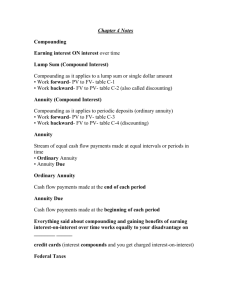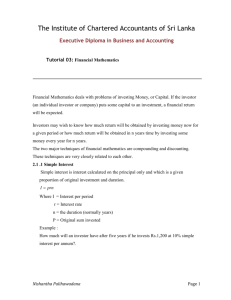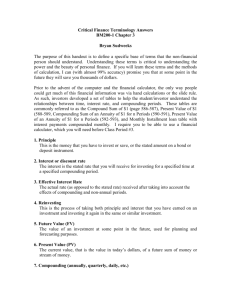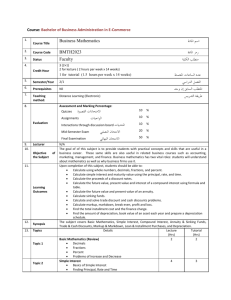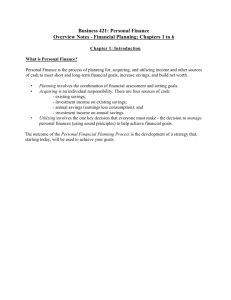Compound interest
advertisement
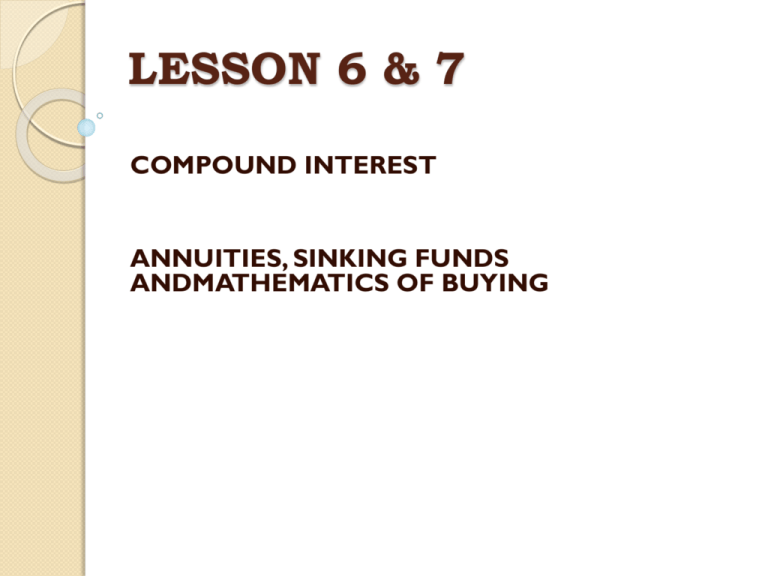
LESSON 6 & 7 COMPOUND INTEREST ANNUITIES, SINKING FUNDS ANDMATHEMATICS OF BUYING Learning Outcomes By the end of this lesson, should be able to: ◦ Understand the definition of compound interest. ◦ Identify interest rate per compounding period and number of compounding periods. ◦ Calculate the future value and the compound interest using the Compound Interest Table and formula. Learning Outcomes By the end of this lesson, students should be able to: ◦ Calculate the present value of an ordinary annuity Calculate sinking funds Know how an invoice looks like. Calculate single trade discounts and net cost Calculate series of trade discounts and net cost Express a series discount as an equivalent single discount ◦ Find the list price ◦ ◦ ◦ ◦ ◦ Learning Outcome (contd.) ◦ Understand cash discount ◦ Determine the cash discount due dates ◦ Calculate cash discount using ordinary dating method ◦ Calculate cash discount using post-dated (AS OF) method ◦ Calculate cash discounts using end-of-month (EOM) dating method ◦ Calculate cash discount using receipt-of-goods (ROG) dating method Learning Objectives () ◦ Calculate the present value of a compound interest using Compound Interest Table and formula. ◦ Understand the underlying hukum for compound interest in Islam ◦ Calculate the future value of an ordinary annuity ◦ Calculate the future value of an annuity due Compound interest Compound interest is interest calculated on any interest previously credited to an account in addition to the original principal. It is the amount of interest earned on principal and on previously earned interest that has been added to the principal. It is used in many long-term investments, such as savings accounts or certificates of deposit at a bank. The amount an investment will be worth at the end of some future period of time when interest is compounded is called the future value, the compounded amount or the maturity value. Identifying interest rate per compounding period and number of compounding periods For compound interest, interest is usually compounded daily, monthly, quarterly, semi-annually, or yearly. The number of interest payment period in each year for each method is shown in the next slide in table form. The formulas involved in calculating the interest rate per compounding period and number of compounding period per year include: i =R/k and n=kT Contd… i – Interest per compounding period R – Annual interest rate k – No. of compounding period per year T – Time in years n – Total number of compounding periods Interest Compounded Compound at the End of Every Number of Compounding Periods in 1 Year, k Annually 12 months Once a year Semi-annually 6 months 2 times a year Quarterly 3 months 4 times a year Monthly 1 month 12 times a year Daily 1 day 365 times a year Future value of a compound interest Maturity value is the future value of the investment, or the amount an investment will be worth at the end of future period of time when interest is compounded. There are 2 ways of calculating future value or maturity value and compound interest (1) by using the formula (2) by using the Compound Interest Table. Maturity value Interest M P1 i n I M P M – Maturity value P – Principal i – Interest rate per compounding period. n – Total number of compounding periods I – Interest M – Maturity P – Principal Finding Future Value and Compound Interest using the Compound Interest Table To calculate the compound amount with a future value table, the following steps are involved: Find the period interest rate, i =R/k Find the number of compounding period, n=kT Find the factor of the future value of RM 1 at the intersection of the period interest rate and the number of periods (i,n) in the Compound Interest table. Multiply the factor by the principal amount. This will give the compound amount, or the future value, or the maturity value. Maturity value = Principal x factor from the Compound Interest table. To find the amount of interest earned: l =M-P Present value of a compound interest Present value It is the amount of money to be deposited today to produce the needed amount in the future at a specified date. For example, a manufacturing company would want to know the amount of money to keep aside or invest today in order to have enough money to buy new equipments in 3 years. 2 ways are involve in calculating the present value (1) by using the formula (2)the Present Value of a RM 1 Table Finding Present Value using the Formula , PV M 1 i n where PV – Present Value M – Maturity value / Future value i – Interest rate per compounding period n – Total number of compounding periods i R , n kT k where R – Interest rate k – Number of compounding period per year T – Time in years I M P where I – Interest, M – Maturity value P - Principal Finding Present Value using the Present Value of a RM 1 Table To calculate the present value with a present value table, the following steps are involved: Find the period interest rate, i =R/k Find the number of compounding period, n= kT Look at the intersection of the two columns (i, n) in the present value table to get the factor for the compound amount of RM 1. Multiply the factor by the future value amount. This will give the present value. PV = M x number from Present Value of a dollar Table To find the interest earned, I = Future Value – Present Value. Compound interest in Islam During the pre-Islamic era, when interest is considered normal, a person who fails to pay back the principal and interest charged on him, the lender extends the loan on the condition that the interest will also become part of the loan (essentially Compound Interest). Quran verses were revealed in order to stop the people from such practices: "O believers, take not doubled and redoubled interest, and fear God so that you may prosper." (Quran 3:130-1) Annuity payment An annuity is a series of equal payments made or received at regular time intervals. Examples of annuities are monthly payments of housing loans, car loans, and insurance. Each payment earns compound interest until the end of the term of the annuity. The total amount in the account at the end of the term is called the amount of the annuity or future value of the annuity. Contd… The time between payments is called payment period and the time from the beginning of the first payment period through the end of the last payment period is the term of the annuity. There are 2 types of annuity: Ordinary annuity: Investments or payments that are made at the end of each period. For example: salary. Annuity due: Investments or payments that are made at the beginning of each period. For example: life insurance, house rent. Ordinary annuity (Using formula Approach) Table Approach To calculate the future value of an ordinary annuity using Amount of an Annuity Table, use the following steps: Find the period interest rate. Find the number of compounding period. Look at the intersection of the two columns in the Amount of an Annuity Table to get the factor for future value of an annuity. Multiply the factor by the amount of annuity payment. This will give the amount of an annuity, or the future value of the annuity. To get the interest earned: interest = Amount – (n x payment) Main differences The main difference between an ordinary annuity and annuity due is that an ordinary annuity will not earn interest in the first period because the investment is made at the end of the period. An annuity due earns interest in the first period, and that interest will be compounded over the entire length of the investment period. Present value of an ordinary annuity The present value of an annuity finds the value of a lump sum amount that must be deposited today for it to grow to a desired value at a specific date in the future. Suppose a firm needs RM 250,000 at a specific date in the future. The firm can achieve that goal either by making periodic payments into an account for several years, or depositing lump sum into an account and letting the funds grows. The lump sum that can be deposited today is the present value of the annuity involving the periodic payments. There are 2 methods to calculate the present value of an ordinary annuity Using formula where; 1 1 i PVA Payment i n – Present value of an annuity Payment – the amount paid i – Interest rate per compounding period n – number of compounding period Using present value of an annuity table The steps involved to find the present value from an annuity table are as follows: Find the period interest rate, i =R/k and the number of compounding periods, n =kT Find the intersection of the interest rate per compounding period and the number of compounding periods per year. Calculate the Present Value of an Annuity using the following formula. PVA = Payment x number from Present Value of an Annuity table. Find the interest earned : I = Amount - (n x payment) Sinking funds A sinking fund is a fund set up to receive periodic investments to achieve a specific future value at a specific future date. A sinking fund table is used to determine the periodic amount to be invested on a regular basis to accumulate a known, lump sum future value. There are 2 ways of calculating sinking fund Using Formula 1. Formula to calculate sinking funds. where; 2. Formula to calculate Interest. SF – Sinking Funds M – Maturity value SF M i 1 i n 1 I M n payment i – interest per compounding period n – number of compounding periods Using Table The steps you need to follow are: Find the period interest rate and number of compounding periods per year. Find the intersection of the periodic payment and the number of periods per year. Find the periodic amount to be invested. SF = M x Number of sinking fund table Calculate interest earned: I = M - (n x payment) Invoice An invoice is a printed document for record the transaction between seller and buyer. For seller, it is a sales invoice, and for buyers, it is a purchase invoice. The invoice identifies the seller and buyer, describes the items purchased, quantity purchased, unit list price, discount terms, and shipping and insurance charges. Trade discounts and net cost Trade discount is a business term used for slashing off the original selling price (list price) of an item and not related to early payment, resulting in net cost or net price. Formulas to find the trade discounts and net cost are as follows: Trade discount = List price x Trade discount rate Net Cost/Price = List Price – Trade Discount Cash discounts Business sellers often grant time to business customers (example 30 days) to pay for the merchandise purchased. Sellers encourage the buyers to pay promptly as they require the cash for their operations. Therefore, cash discount is offered by sellers to encourage prompt payment of bills by customers. Cash discount is shown in the invoice as part of the terms of sales. Thus, it is important to understand the method to calculate cash discounts. Methods of computing cash discounts Ordinary dating method This method is the most commonly used method for determining cash discounts. The date and net payment date are counted from the date of the invoice. Cash discounts are generally shown in an invoice such as: 3/10, n/40 OR 3/10, net 40 Read as “three ten, net forty” First digit is the rate of discount (3%) Second digit is number of days allowed to take the discount (10 days) n/40, net 40 is the total number of days given to pay the invoice in full. Contd…. • Post-dated (AS OF) method Sometimes an invoice is post-dated to give the buyer more time to take the cash discount. This method calculates the discount period and the net payment date starting from the given AS OF date. For example, an invoice dated July 25 AS OF August 1 will have both cash discount date and net payment date counted from August 1. Contd… • End-of-month (EOM) dating method End-of month dating is similar to proximo dating. It is written as such 5/10 EOM, and 5/10 prox. which means that the buyer will get 5% cash discount if payment is made by the 10th of the month that follows sale. If the invoice is dated on 20 March with terms of 3/10 EOM, then the cash discount period is up until 10 April. Receipt-of-goods (ROG) dating method The discount period and the net payment period begin when delivery is made. Abbreviated as ROG, this dating method gives the buyer time to receive and inspect the goods to ensure the merchandise received was in good condition. The method also allowed the buyer to benefit from a cash discount. An invoice with terms of 6/15 ROG, means 6% cash discount is given if the invoice is paid within 15 days from the receipt of goods. Lessons Summary The lesson teaches students how to calculate compound interest through two approaches- by using the formula and the Compound Interest table. Islam prohibits the act of charging interest to the borrower. Both borrower and lender are answerable to God for their deeds. Lesson Summary The topic explains the basis for annuity payments and its calculation. There are a few cases where may be involved in annuity payments in life. Students should be familiar with way of computing annuity in order to accumulates money for some personal reasons in the future. Contd.. Similarly, students have learnt the knowledge involving trade and cash discounts that usually accompanies buying and selling of goods between business to business buyers. Students are reminded to use the number of each day of the year table to facilitate calculation for discounts when offered.



